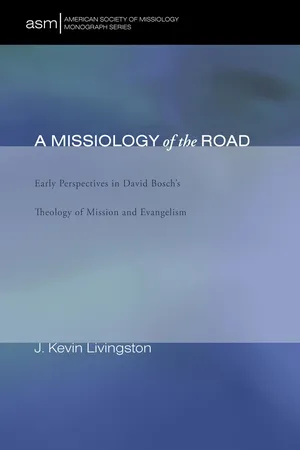1
Apartheid and Afrikaner Identity
The life and witness of David Jacobus Bosch represented a systematic and creative theological response to the missionary and evangelistic challenges facing the Christian church in the latter half of the twentieth century. In the chapters that follow we will explore this response, but first it is necessary to outline the forces that shaped Bosch’s personal and theological pilgrimage. These elements provide the larger “context” through which Bosch’s missiological perspective can be understood and analyzed.
It is never a simple task to grasp the contours of human identity. In an essay on the life of Beyers Naudé, Charles Villa-Vicencio has noted that “it is a risky business to delve into the dark recesses of the human psyche or the social maze of character formation, in order to explain a life . . .” While we make no claim of being able to explain a life as complex as Bosch’s, it is vital to highlight those components that fundamentally molded his mind and character.
David Bosch was a fascinating blend of four worlds. First he was an Afrikaner, indelibly marked by the white South African experience. Second, Bosch was an academic theologian, trained in the classic European tradition. His extensive missiological writings, wide in range and systematic in scope, bear witness to his continental training. Third, Bosch was a missionary. Again and again in his writings one senses a cross-cultural sensitivity and a pastoral concern borne from years of missionary service. Finally, Bosch was an ecumenically minded churchman with a passionate concern for reconciliation between churches, races and theological camps. This blend of four identities (Afrikaner, academic, missionary, churchman) makes any analysis of Bosch’s thought a complex affair. In this chapter we will first consider the Afrikaner legacy Bosch inherited. Although we are not concerned to give a comprehensive account of Afrikaner history, it provides the fundamental historical context within which Bosch’s theology of mission was forged. We will then review the relationship of the Dutch Reformed Church to the ideology of apartheid that reigned in South Africa from 1948 to 1994. Almost all of apartheid’s stalwart defenders emerged from this tradition, as did many of apartheid’s severest critics—including David Bosch.
The Afrikaner Heritage and the Ideology of Apartheid
Apartheid and Ideology: An Introduction
Particularly since Bishop Desmond Tutu received the 1984 Nobel Peace Prize, the struggle against the South African government’s system of apartheid received renewed attention and widespread condemnation, leading to its collapse with the release of Nelson Mandela in 1990 and four years later, South Africa’s first truly democratic general election. But for forty-six years, South Africa’s rigid system of racial separation and white political and economic dominance made it the pariah of the international community. To the outside observer, the South African situation was a blatant example of white racism, pure and simple.
The ironic factor was that many white South Africans not only accepted and endorsed the apartheid system, but also claimed a Christian basis for doing so. “Separate development” was not only been a pragmatic policy for white self-preservation; it was seen as a God-ordained means to preserve the Afrikaner people and “Christian civilization” in southern Africa. Writing at the height of the church struggle against apartheid, South African theologian Allan Boesak wrote:
Most Afrikaners denied any racist motives in their desire to keep races separate. The outrage of the international community against the apartheid system was matched by the contempt and moral indignation that most Afrikaners felt toward outsiders who did not understand the peculiar dynamics of the South African situation.
The facts of apartheid have been well documented. At the time of apartheid’s collapse in the early 1990s, there were approximately 31 million inhabitants of South Africa. Some 22.7 million of these were black Africans, divided into sixteen major language groups. The next largest population group were the whites, with some 4.5 million. Although the whites hailed from numerous European backgrounds, they were divided into two distinct subgroups: those whose first language was Afrikaans (60%) and those whose mother tongue was English (40%). The third largest group was classified as “Coloured.” This racially mixed group constituted nearly 2.8 million persons. They were the offspring of unions between the early Dutch settlers and slaves or indigenous peoples. The fourth group was made up of those of Indian descent, some 870,000 persons.
Through a comprehensive set of laws, the apartheid structure maintained white supremacy since 1948 when the pro-apartheid Nationalist Party came to power. Apartheid divided the population into the aforementioned groups. Under apartheid, people’s whole lives were determined by their racial classification, established at birth. This classification decided what kind of schools and hospitals they could use. It governed where they had to live. It determined what careers would be open (or closed) to them, which university they could attend, which parks they might visit, in which restaurants they could eat.
At the heart of the Afrikaner vision of apartheid (literally “apart-ness”) was the belief that different racial and ethnic groups had a right to separate self-determination. The ideologues of apartheid argued that every volk (people) has an inherent right to preserve their separate identity, embodied in separate political and social structures. The government, therefore, established ten “homelands” for black Africans, based on the model of separate development, with each volk, in theory, controlling its own affairs.
Yet apartheid was much more than a staunch policy of enforced segregation between the races. The tragic disparities between black and white revealed the fundamental inequality and injustice of apartheid. Although whites composed only 15% of the population, they had been allocated 84% of the available land, leaving the majority black population with a mere 16%. Blacks had a much higher infant mortality rate, directly attributable to the lack of adequate health care and proper nutrition. In 1982–83, the South African government spent 1,385 Rand for the education of every white student, but only 593 Rand for every Coloured student and a mere 115 Rand for every...
